Hello!
Well, here it is. This has been a bit of a long time coming, as you'll see. I had to wait for a good deal of shipping from China.
I wanted to be able to do some battery testing and comparison, mostly for my own curiosity, but if I can share my findings with people that appreciate them that makes me happy
Methods
Sadly, I can't afford those super nice BK Precision loads. However, there's a Chinese version that's far simplified made by ZKE Tech that I used for all of my tests.
How accurate is it though? Well, it matches up with the family Fluke 27/FM multimeter, which is the most accurate thing I have access to. So take it for what you will. Mostly, we're looking for a comparison so absolute accuracy isn't 100% important as long as our error is the same all the way through.
The ZKE Tech setup does use a very unique battery holder that uses large chrome terminals for the current, and a gold plated pogo pin that goes up the center of that (and is insulated from it) for the voltage measurement. I was pretty impressed by that, but what was not impressive was that ALL of the flux on it was conductive and the whole thing needed to be taken apart and cleaned thoroughly.
The control unit seems to be based around an Atmel microcontroller, and uses a Dale R01F resistor for the current shunt.
ZKE makes a semi-proprietary serial->USB cable for communicating with the device, however the ebay listings for the cable show the pinout of it, so I made my own and used an FTDI based serial adapter instead of the Prolific one, as I've found FTDI chips to be better behaved for transfering data over long periods of time.
As you'll see, I've tested all of the batteries at specific currents, and the same currents across the board.
All of the batteries went through a "refresh" cycle on my BC-700 charger, so each was at its maximum capacity.
All the tests were done in a ~75 degree F ambient space.
Test Subjects
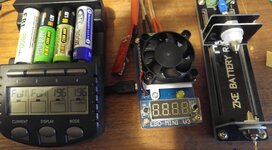
Test Results
Capacity Tests - Fresh off the charger
250mA discharge rate
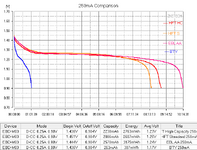
There really isn't any surprises in these tests and the graphs all pretty much look the same.
At this point I drew an X over the last 0 on the BTY battery so it read 300 instead of 3000.
Clearly, the EBL battery having a higher capacity is the most far out. The BTY battery curve does actually look like the others, just that it's so compressed on this scale.
The results carry on to the 500mA test
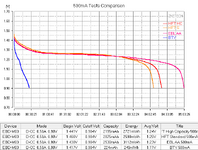
Again, no big surprises. We can see the mAh rating go down as we're using a higher current, as to be expected. Most of the cells saw a 1-2% drop in mWh going from 250mA to 500mA, however the BTY cell saw a 19% drop.
On to the 750mA test
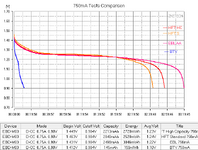
At this point I'm wondering if its even safe to continue with the BTY cell. The BTY cell gave us a 40% drop in mWh going from 500mA to 750.
But I did continue on
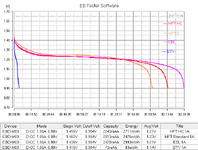
The BTY cell failed to not disappoint again, with a 48% drop in mWh.
Well, just to give a better representation of that BTY cell, here it is on a graph all by its lonesome
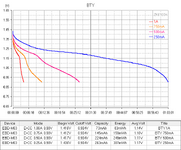
Oh, well, uhm, hm. That's one sick battery.
Low Self Discharge Tests
Since "Low self discharge" is a marketing term invented by Sanyo, I couldn't really find an official specification for it, except that Eneloop cells claim to loose less than 10 or 15% of their capacity after 1 month.
So I fully charged our cells, and let them sit from September 3 to October 1, a period of 4 weeks.
The 1 month test was done at 500mA.
HFT standard capacity

Now, when I labled these charts I was doing that percentage based on the mAh and not the mWh. If we go by mWh, 87% of the capacity was retained. With a 13% loss, these fall under the more loose guidelines of being low self discharge, even though they're not marketed as such.
The standard capacity HFT cells are simular

Again, silly me, labeling thigns based on mAh. If we go based on mWh, we get 85% retention. Which still falls under the looser guidelines of being low self discharge.
The EBL batteries start to get interesting
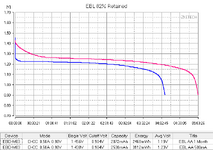
Going based on mWh, we get a 79% retention rate. Which barely misses that LSD guideline, even though these are marketed as being LSD cells.
Now the BTY...
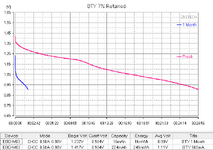
Oh... oh.. That's painful. That's a 6% retention... Well, these aren't sold as low self discharge at least. I'm beginning to suspect these might be NiCD cells... really really crap NiCD cells.
Final verdict
BTY cells a score of "literal garbage" out of 10. Don't buy these.
EBL cells score a solid 5/10. Maybe not buy these. At best, they don't live up to the claims.
Harbor Freight batteries... I'd give them a solid 8/10. A 4 pack of the standard ones is $6 and the High Capacity ones are $1 more. Its up to you if that extra dollar is worth it.
Disclaimers
I have no affiliation with any of the companies mentioned, I purchased all tools and batteries myself. Buy batteries from China at your own risk.
Hopefully I can be of help to folks out there I plan on testing many more batteries, and next round will be some alkaline AA cells, if I'm not just immediately banned.
I plan on testing many more batteries, and next round will be some alkaline AA cells, if I'm not just immediately banned.
Well, here it is. This has been a bit of a long time coming, as you'll see. I had to wait for a good deal of shipping from China.
I wanted to be able to do some battery testing and comparison, mostly for my own curiosity, but if I can share my findings with people that appreciate them that makes me happy
Methods
Sadly, I can't afford those super nice BK Precision loads. However, there's a Chinese version that's far simplified made by ZKE Tech that I used for all of my tests.
How accurate is it though? Well, it matches up with the family Fluke 27/FM multimeter, which is the most accurate thing I have access to. So take it for what you will. Mostly, we're looking for a comparison so absolute accuracy isn't 100% important as long as our error is the same all the way through.
The ZKE Tech setup does use a very unique battery holder that uses large chrome terminals for the current, and a gold plated pogo pin that goes up the center of that (and is insulated from it) for the voltage measurement. I was pretty impressed by that, but what was not impressive was that ALL of the flux on it was conductive and the whole thing needed to be taken apart and cleaned thoroughly.
The control unit seems to be based around an Atmel microcontroller, and uses a Dale R01F resistor for the current shunt.
ZKE makes a semi-proprietary serial->USB cable for communicating with the device, however the ebay listings for the cable show the pinout of it, so I made my own and used an FTDI based serial adapter instead of the Prolific one, as I've found FTDI chips to be better behaved for transfering data over long periods of time.
As you'll see, I've tested all of the batteries at specific currents, and the same currents across the board.
All of the batteries went through a "refresh" cycle on my BC-700 charger, so each was at its maximum capacity.
All the tests were done in a ~75 degree F ambient space.
Test Subjects
- EBL AA Battery
- 2800 mAh claimed capacity
- "Low self discahrge" claimed
- 2750 mAh measured on BC-700 - Claim not met
- BTY AA battery
- 3000 mAh claimed capacity
- Not claiming to be LSD
- 320mAh meausred on BC-700 - Claim not met
- Harbor Freight Tools "Thunderbolt Magnum" Standard capacity
- 2000 mAh Claimed capacity
- Not claiming to be LSD
- 2200 mAh measured on BC-700 - Claim exceeded
- Harbor Freight Tools "Thunderbolt Magnum" High Capaicty
- 2200 mAh Claimed Capacity
- Not claming to be LSD
- 2400 mAh measured on BC-700 - Claim exceeded

Test Results
Capacity Tests - Fresh off the charger
250mA discharge rate

There really isn't any surprises in these tests and the graphs all pretty much look the same.
At this point I drew an X over the last 0 on the BTY battery so it read 300 instead of 3000.
Clearly, the EBL battery having a higher capacity is the most far out. The BTY battery curve does actually look like the others, just that it's so compressed on this scale.
The results carry on to the 500mA test

Again, no big surprises. We can see the mAh rating go down as we're using a higher current, as to be expected. Most of the cells saw a 1-2% drop in mWh going from 250mA to 500mA, however the BTY cell saw a 19% drop.
On to the 750mA test

At this point I'm wondering if its even safe to continue with the BTY cell. The BTY cell gave us a 40% drop in mWh going from 500mA to 750.
But I did continue on

The BTY cell failed to not disappoint again, with a 48% drop in mWh.
Well, just to give a better representation of that BTY cell, here it is on a graph all by its lonesome

Oh, well, uhm, hm. That's one sick battery.
Low Self Discharge Tests
Since "Low self discharge" is a marketing term invented by Sanyo, I couldn't really find an official specification for it, except that Eneloop cells claim to loose less than 10 or 15% of their capacity after 1 month.
So I fully charged our cells, and let them sit from September 3 to October 1, a period of 4 weeks.
The 1 month test was done at 500mA.
HFT standard capacity

Now, when I labled these charts I was doing that percentage based on the mAh and not the mWh. If we go by mWh, 87% of the capacity was retained. With a 13% loss, these fall under the more loose guidelines of being low self discharge, even though they're not marketed as such.
The standard capacity HFT cells are simular

Again, silly me, labeling thigns based on mAh. If we go based on mWh, we get 85% retention. Which still falls under the looser guidelines of being low self discharge.
The EBL batteries start to get interesting

Going based on mWh, we get a 79% retention rate. Which barely misses that LSD guideline, even though these are marketed as being LSD cells.
Now the BTY...

Oh... oh.. That's painful. That's a 6% retention... Well, these aren't sold as low self discharge at least. I'm beginning to suspect these might be NiCD cells... really really crap NiCD cells.
Final verdict
BTY cells a score of "literal garbage" out of 10. Don't buy these.
EBL cells score a solid 5/10. Maybe not buy these. At best, they don't live up to the claims.
Harbor Freight batteries... I'd give them a solid 8/10. A 4 pack of the standard ones is $6 and the High Capacity ones are $1 more. Its up to you if that extra dollar is worth it.
Disclaimers
I have no affiliation with any of the companies mentioned, I purchased all tools and batteries myself. Buy batteries from China at your own risk.
Hopefully I can be of help to folks out there

